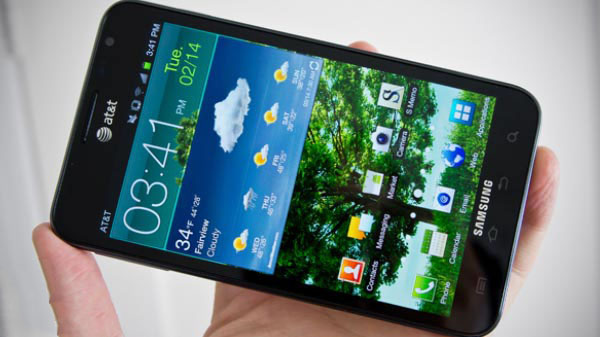Usability Impressions, Calling / Data, Apps
Samsung has equipped the Galaxy Note with impressive internal hardware: a 1.5GHz dual-core processor, 1GB of RAM, and 16GB of internal storage (with just under 13GB available to the user). With those kind of specs, one would assume that the Note would fly when it comes to pushing around Android 2.3.6 Gingerbread and Samsung's TouchWiz interface. Unfortunately, the Galaxy Note exhibits noticeable lag throughout the OS, which, while it is small at first, adds up to be quite frustrating over time.
In my experience, Samsung's earlier Galaxy S II models performed more smoothly and the global version of the Galaxy Note (sans LTE) is also a speedy performer. This leads me to believe that the software on this particular Note for AT&T is not fully optimized to take advantage of the hardware underneath. Samsung and AT&T have promised an upgrade to Android 4.0 Ice Cream Sandwich for the Galaxy Note, which will hopefully address the user interface lag that I have experienced with the device.

The version of TouchWiz that is on the Galaxy Note is similar to what we've seen on Galaxy S II smartphones, though it has been slightly tweaked to take advantage of the Note's larger display. Instead of room for four icons across the screen, the Note allows users to place five icons in one row, and some of Samsung's TouchWiz widgets are resizable for more control over customization of the home screens. The lock screen has also been tweaked to allow weather information to be displayed along with the date and time.
The S Pen input device that is included with the Note can be used to control the phone just as you would with your finger. Its fine point is very precise, especially for performing tasks that require more dexterity than your finger offers. Unfortunately, the S Pen is not recognized by the capacitive buttons below the screen, so you have use your finger for those. You can use the S Pen to input text Graffiti-style, but that has proven to be very tedious and slow.
The default keyboard that Samsung designed for the Note is massive, and takes up almost half of the large display. It is not possible to turn off the haptic feedback in Samsung's keyboard, which I quickly found to be annoying. The Note also comes with the Swype keyboard, which is as large as the Samsung keyboard, and the standard Android 2.3 Gingerbread keyboard, which I found easier to type with because of its smaller size.
The Samsung Galaxy Note features support for AT&T's burgeoning 4G LTE network, and for those that happen to live in the few markets where AT&T is currently offering LTE service, data speeds are nothing short of astounding. Though Verizon's LTE network has always proven to be fast, AT&T's new network doesn't yet have nearly as many users and repeatedly offers download speeds in excess of 20Mbps and upload speeds nearing that number. For the rest of us that don't live under AT&T's limited LTE umbrella, the Galaxy Note offers impressive performance on AT&T's HSPA+ network, with download speeds hitting 5Mbps and uploads in excess of 2Mbps.
The Galaxy Note performs on par with older Samsung smartphones when it comes to making calls - if you can get over how absurd it looks to hold such a massive device up to the side of your face. Call audio is clear, if not outstanding, and the speakerphone got loud, but the sound was rather thin.

The Samsung Galaxy Note features the same SMS/MMS client as seen on other TouchWiz-equipped phones, and it has an attractive interface with threaded and bubbled conversations. The Note does not have any out of the box support for instant messaging services other than the native Android Google Talk app, but it does feature AT&T's new Messages service that aggregates all of your text messages, missed calls, and voicemails in one spot - and gives you access to them from any web browser, to boot.
Samsung's custom email client really looks great on the Note's large display, and it features a two-pane view when you rotate the Note into landscape mode. There was a noticeable and frustrating lag when scrolling through emails within the app, but pinch-zooming on messages was fluid. The email app supports POP3, IMAP, and Exchange accounts, though Gmail users can also use the native Gmail for Android app that comes with the Note.

Samsung has included a couple of apps with the Galaxy Note that take advantage of the large screen and S Pen input, but I wish there were more available to really make use of the Note's unique capabilities. The custom calendar app is awesome, and uses the Note's large, high-res display to show a ton of information at once. For the S Pen, the S Memo app is where all of the fun is, as it allows you to take hand written notes, create drawings, edit screenshots, and create collages with images.
The S Pen also has an S Memo lite app that launches when you hold the S Memo's button and double tap the screen. You can use S Memo lite to quickly take notes from wherever you are and then import them into the full S Memo app for further editing and tweaking. Samsung has released an SDK for developers to incorporate S Pen functions into their own apps, but we don't know if any are actually planning to make use of it.




